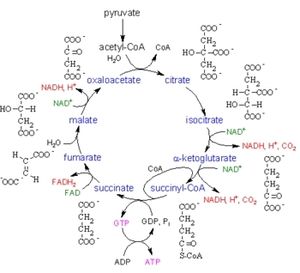Krebs cycle
The Krebs cycle, also known as the citric acid cycle or the tricarboxylic acid cycle, is one of the most important reaction sequences in biochemistry. Not only is this series of reactions responsible for most of the energy needs in complex organisms, the molecules that are produced in these reactions can be used as building blocks for a large number of important processes, including the synthesis of fatty acids, steroids, cholesterol, amino acids for building proteins, and the purines and pyrimidines used in the synthesis of DNA.
Fuel for the Krebs cycle comes from lipids (fats) and carbohydrates, which both produce the molecule acetyl coenzyme-A (acetyl-CoA). This acetyl-CoA reacts in the first step of the eight step sequence of reactions that comprise the Krebs cycle, all of which occur inside mitochondria of eukaryotic cells. While the Krebs cycle does produce carbon dioxide, this cycle does not produce significant chemical energy in the form of adenosine triphosphate (ATP) directly, and this reaction sequence does not require any oxygen. Instead, this cycle produces NADH and FADH2, which feed into the respiratory cycle, also located inside of the mitochondria. It is the respiratory cycle that is responsible for production of large quantities of ATP and consumption of oxygen. In addition, the respiratory cycle converts NADH and FADH2 into reactants that the Krebs cycle requires to function. Thus, if oxygen is not present, the respiratory cycle cannot function, which shuts down the Krebs cycle. For this reason, the Krebs cycle is considered an aerobic pathway for energy production.
